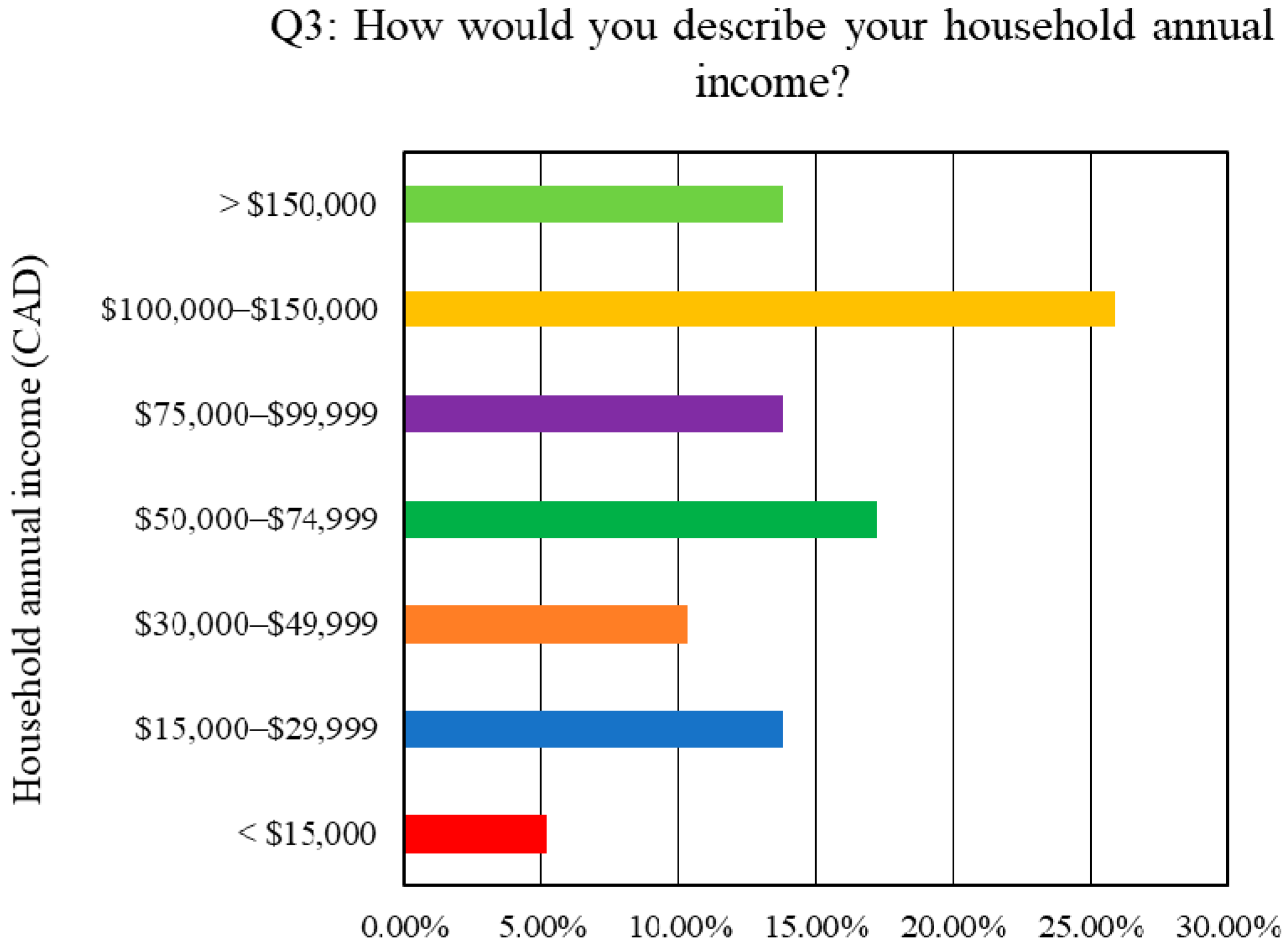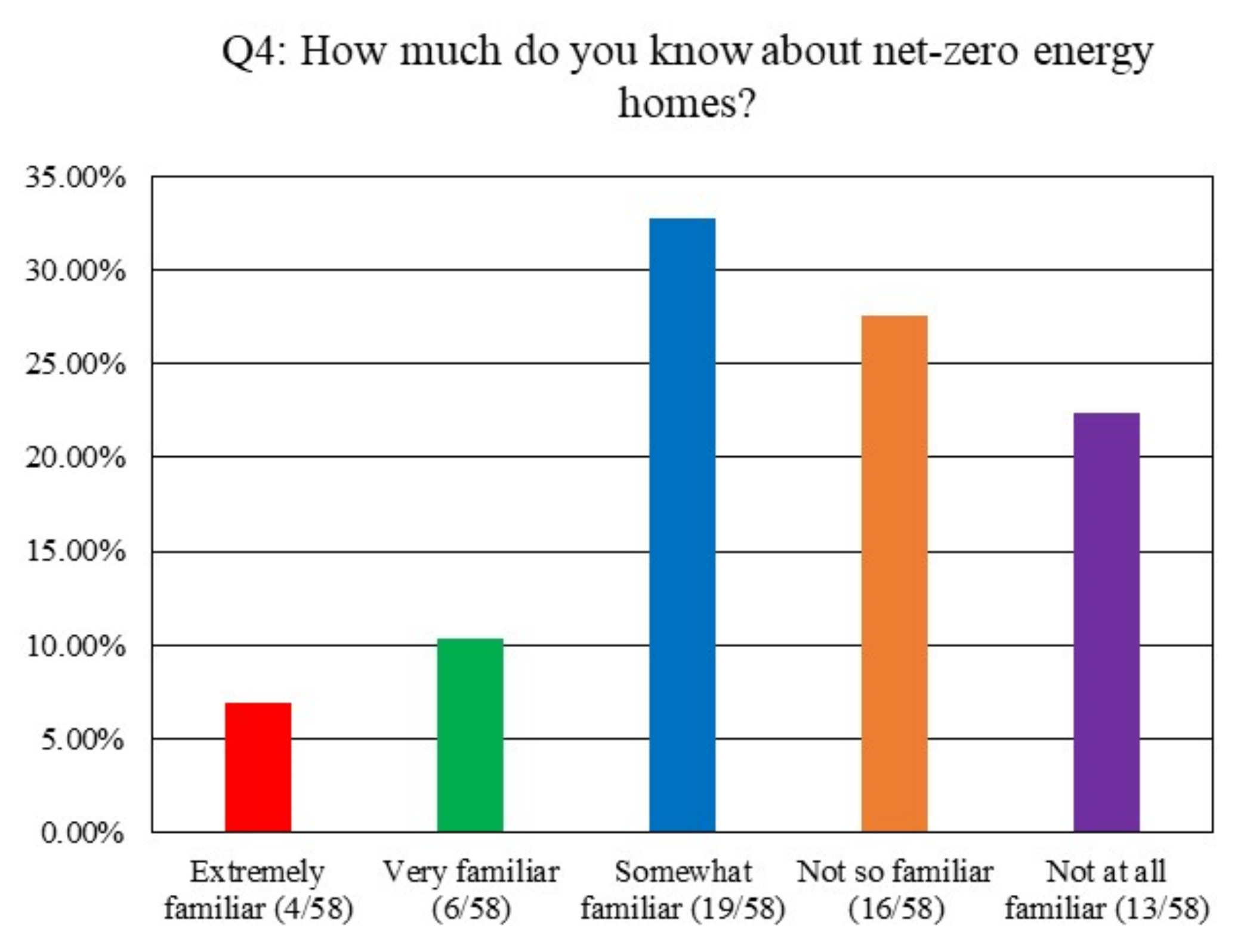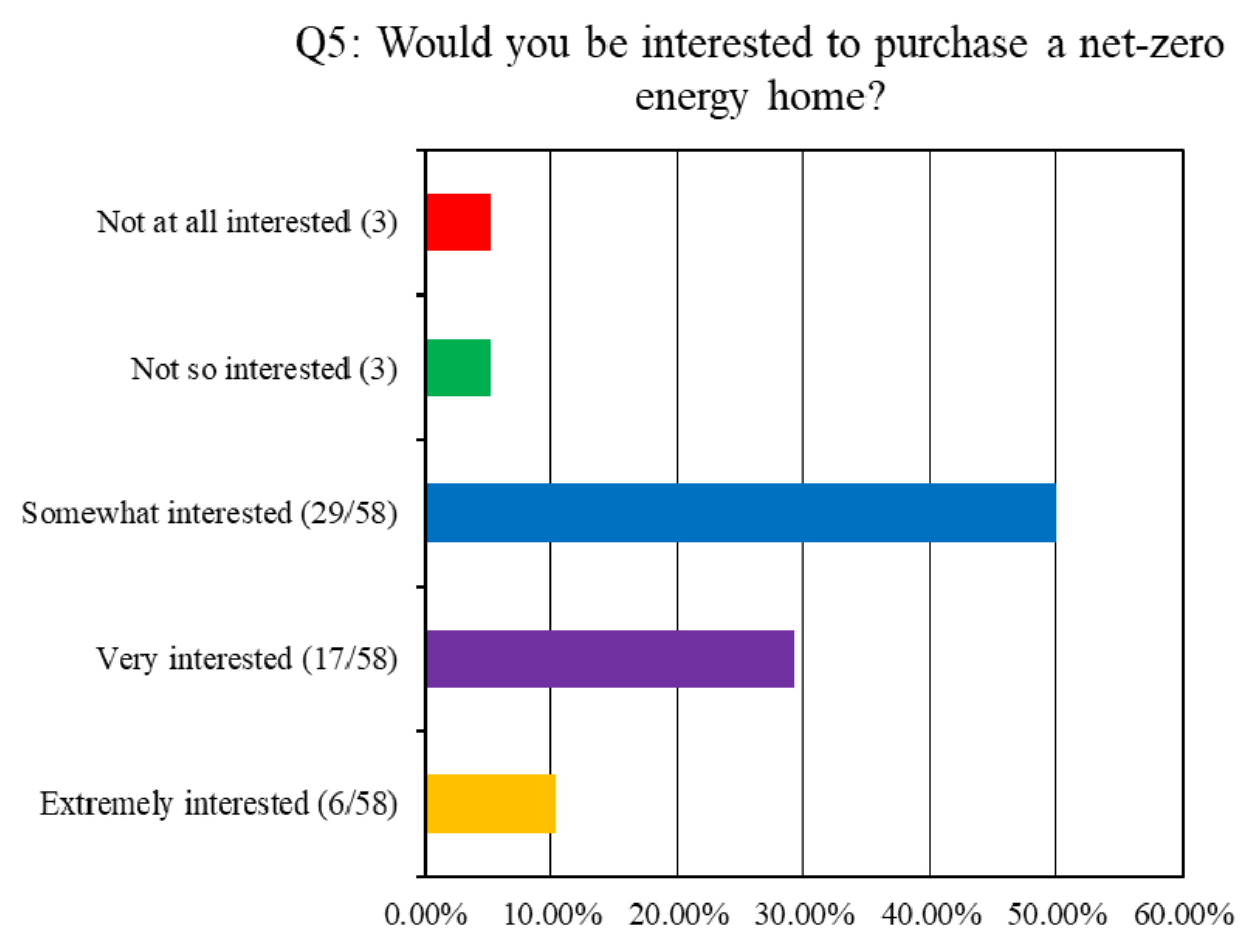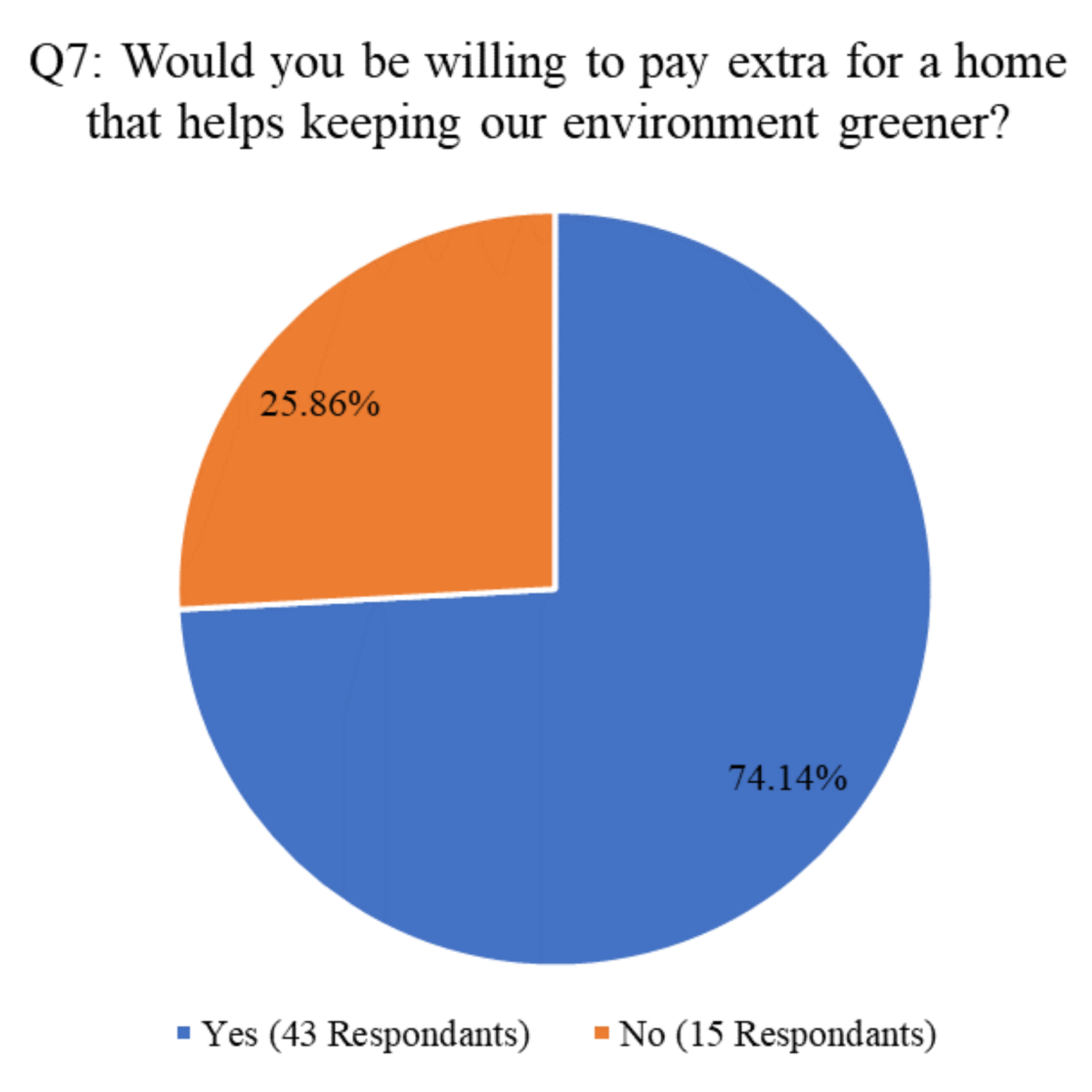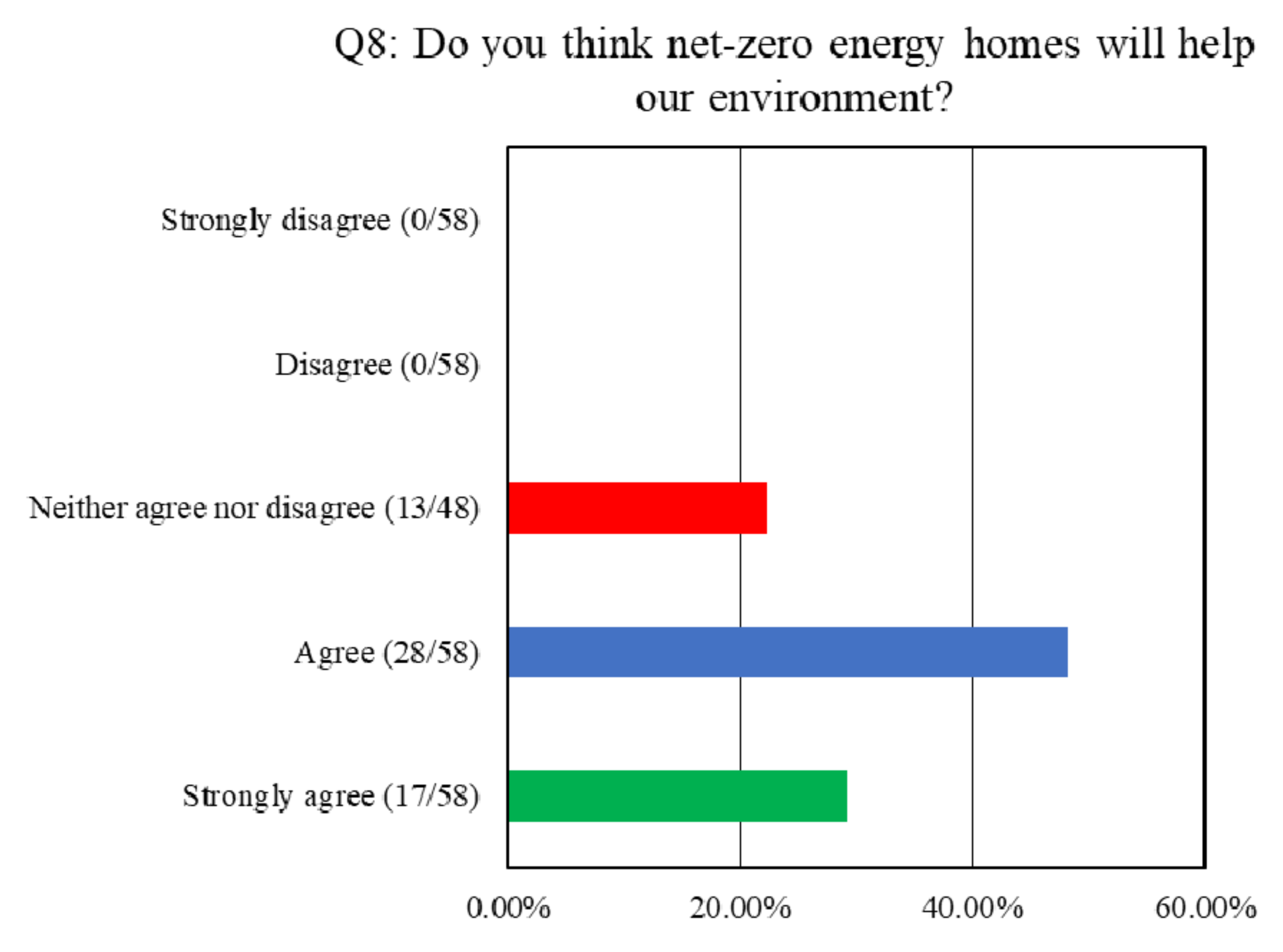1. Introduction
Every year, numerous commercial, industrial, institutional, and residential buildings are constructed around the world. Iyer-Raniga [
1] reported that almost 235 × 10
9 m
2 of building floor area was constructed by 2016, and an additional 230 × 10
9 m
2 will be constructed by 2056. A large amount of energy is required to operate the buildings, which may significantly add to greenhouse gas (GHG) emissions if non-renewable energy sources are used. Ontario consumes a significant portion of primary energy in its building sector, and as a developing region, this share is estimated to continue to grow in the future due to today’s fast urbanization. Buildings account for around 33.3% of the final energy demand and 30% of GHG emissions in the globe [
2]. As of 2018, buildings were the largest source of GHG emissions in Toronto, accounting for about 55% of the total community-wide emissions [
3]. This is concerning with respect to the effects of GHG emissions on the environment. Therefore, more efficient buildings are required for energy savings and reduced environmental pollution. The goal of net-zero energy (NZE) buildings is to produce enough renewable energy to meet buildings’ annual energy consumption requirements by zeroing the use of non-renewable energy [
4,
5,
6], thus decreasing GHG emissions [
7]. The annual onsite renewable energy for NZE buildings should be equal to or greater than the actual annual energy demand [
8,
9]. Achieving this energy condition is not very straightforward. This paper analyzes the different obstacles to constructing commercial, industrial, institutional, and residential NZE buildings across the Greater Toronto Area (GTA) with a focus on single-family homes.
NZE buildings require both energy-saving and energy-producing approaches. Passive solar design, effective building envelope, energy-efficient appliances, and renewable energy sources are essential for these buildings. The energy requirement of buildings can be reduced by orienting the structure properly so that it can gain more solar heat during the winter but less during the summer, and getting daylight is also important as it can reduce the energy spent for indoor lighting [
10]. Moreover, substantial energy can be conserved using high-performance insulation in wall, floor, and roof systems [
11]. Energy consumption in buildings can also be significantly decreased using energy-efficient appliances, HVAC (heating, ventilation, and air conditioning) equipment, and light fixtures [
12]. On the other hand, sunlight and solar heat are commonly used as a source of renewable energy for buildings [
13,
14]. Besides, wind, biomass, and geothermal energy can be used for various building services [
15]. The other aspects such as advanced framing, triple-pane windows, and open-web trusses are also considered for constructing NZE buildings [
16].
Research on NZE buildings recognizes the importance of design and acknowledges the role of construction in the development of these buildings to reduce GHG emissions and reverse the adverse effects of global warming. Certain studies focused the design and technical requirements of NZE buildings, and how they impact the environment [
17,
18]. Many published works show that NZE buildings have been built in different parts of the globe, including Canada, and they are still operating [
14,
19,
20]. However, in Ontario, the past research on NZE buildings mainly focused on energy consumption rather than evidence-based approaches to NZE housing in different areas, including the GTA. Necessary steps were not taken to effectively minimize foremost challenges such as technological barriers, and to increase the governmental and institutional supports for NZE homes. Also, the importance of the public awareness was somehow not prioritized. To build more NZE homes in communities, people who live in those communities and are paying to buy properties must be educated about efficient homes. More awareness will lead to an increase in demand for NZE homes. This study has examined the degree of the public awareness of NZE homes in the GTA.
Natural Resources Canada (NRC) took initiatives in 2013 to enhance the development of NZE buildings in Canada, starting with a pilot project called “The R-2000 Net-Zero Energy Pilot” [
21]. The purpose was to encourage and support the Canadian construction companies to build NZE homes, and rate these homes using NRC’s EnerGuide Rating System and mark them under the R-2000 standard. Thereafter, by 2016, six construction companies built twenty-three NZE homes in three provinces, including Ontario, and the feasibility of these homes on a community level in Canada was also demonstrated to increase their acceptance in the housing market [
21]. With all these efforts, NRC has developed the methodology to evaluate the NZE aspects of buildings that includes modified home energy rating scale, whole house energy analysis, assessment of emerging technologies, feasibility studies, mechanisms for enabling construction industry to adopt renewable energy sources, establishment of energy model and guidelines, and field appraisal [
22].
Despite the vast resources and technologies in today’s construction industry, there are many challenges along the way to develop energy-efficient buildings [
23]. NZE homes are built based on certain new technologies, and thus are not yet popular. It is, therefore, important to identify the constraints which may hinder the development of NZE homes. The public awareness is also important because it creates opportunities for the acceptance of new technology. This study first identifies and analyzes the technical, organizational, and social challenges of building NZE homes. Secondly, the study is intended to establish the importance of public knowledge in promoting NZE homes. Finally, the study aimed at providing recommendations on how to raise public knowledge on NZE homes. These recommendations, when applied, could help increase the public awareness of NZE homes and consequently eliminate some of the obstacles during implementation.
2. Literature Review
The intensification of commercial and residential construction within the City of Toronto and close to major transit nodes is contributing to high energy consumption and environmental degradation. Efforts have been put in place to minimize the effects of construction activities and occupancy, but the problem of carbon emissions continues to have harmful effects on the environment. To alleviate this problem, Toronto’s leading developers have developed mechanisms that reduce emissions and improve the energy performance of buildings [
24]. One such mechanism is the adoption of NZE technology for making homes. Various definitions of NZE homes exist but the overall concept is having a building which generates as much energy as it consumes with zero carbon emissions. Iyer-Raniga [
1] defines the NZE home as a building that has annual net-zero energy consumption from the power grid and net-zero carbon emissions. NRC agrees that an NZE home focuses on producing at least as much energy as it requires on an annual basis [
22]. Numerable new buildings have already been built in the GTA and other cities or towns of Ontario using NZE technology [
25,
26,
27]. However, more pace is required to help the government achieve the targets of its climate action plan through reduced carbon emissions.
There are barriers for the development and construction of NZE buildings in the GTA. The lack of knowledge on how to integrate conventional electrical supply to the green energy system of the home by the electric utility company personnel may undermine the performance of energy components and systems. Pettit et al. [
16] observed that NZE design requirements such as advanced framing, open-web floor trusses, high-performance wall and roof enclosure, and solar power integration need advanced skills and expertise. Piderit et al. [
28] agreed that NZE home encompasses a complex system that needs skilled professionals with knowledge across different engineering, scientific, and technical disciplines. The construction industry in the GTA is still adjusting to the multi-disciplinary design approach for NZE buildings. The principal design requirement is to integrate many energy-saving and energy-producing techniques that are suitable and economically feasible for a green construction project. For this, an efficient energy use analysis mechanism helps in the projection of the total annual energy consumption of a building.
Improving energy efficiency is initially costly due to the complex technical requirements of NZE buildings. Also, the energy use in the household may vary from one place to another depending on climate conditions, thus affecting the design and development of NZE homes. Hamilton [
29] reported that surveys on homes with similar energy-saving systems showed variations in energy use across different climates and regions in Canada; for example, the average annual home energy cost in Ontario is
$2358 and that in Nova Scotia is
$2903. Moreover, the initial construction cost becomes higher for NZE homes than traditional homes. The case study of NRC [
22] showed that their NZE home is not yet market-feasible because of the large first cost (
$100,000 to
$150,000) to achieve it. Initial construction costs increase significantly due to the lack of technological knowledge and industry experts who possess the technical skills and experience to maximize the benefits of passive design and install energy-producing components in homes. Hence, certified NZE home builders should be available in plenty to enhance the growth of NZE homes. But green energy developers lack an effective certification and assessment system solely for NZE housing in the GTA. Although Toronto’s leading developers have developed mechanisms to decrease GHG emissions from buildings and enhance their energy performance, the study by Pettit et al. [
16] revealed that Chile and Canada have challenges in establishing the best practices and standards for NZE homes in the construction industry. Although developers are incorporating LEED Canada (LEED means Leadership in Energy and Environmental Design) certification for homes [
30], it is not specially formulated for NZE construction. Without a standardized certification system exclusively for NZE homes, the construction of these homes may fail.
Government policy plays a major role in the development and popularity of NZE homes. The City of Toronto has green standards on energy efficiency and renewable energy for low-rise residential and mid- to high-rise residential and non-residential buildings [
31,
32]. The City also has guidelines regarding the district energy system and operational systems for mid- to high-rise residential and non-residential development [
32]—these standards and guidelines could be useful to support the development of NZE buildings in the GTA. However, McVey et al. [
33] stated that regional regulations limit the ability of local distribution companies to establish district energy networks and serve as aggregators of distributed energy generation and storage resources. Their analysis of the policies indicated that the existing rules on the participation of combined heat and power projects in electricity markets create further barriers for coordinating renewable energy sources into the power system. The lack of policies supporting renewable energy development at the district level undermines the development of NZE homes. Currently, Toronto lacks NZE infrastructures that provide capital and technical support to contractors and specialists. The withdrawal of federal and provincial funding in the Port Lands project debilitated the sustainable development of NZE community buildings. The lack of capital and funding destabilizes the process of innovation in the construction industry through research and development.
Recent trends in building construction create limitations for the development of NZE housing in the GTA. The high costs of labor and land are contributing to unfavorable building design strategies [
24]. For instance, developers are using low-cost building materials and minimizing their residential suite size and floor-to-floor height to address the high land and labor costs. However, these strategies have only served to minimize the costs by compromising the quality of buildings, and they are not conducive to promote NZE homes. Eliminating the barriers to NZE housing by improving micro-power grid access, easing strict permits, and enhancing the process of certification for construction companies will significantly reduce the cost of construction. Zhang et al. [
23] argued that the introduction of utility energy pricing policy will offer developers realistic economic returns for energy efficiency and contribute to reducing GHG emissions. Besides, Wills et al. [
34] identified NZE as a performance target, which has not been implemented by the government. The revision of Canada’s energy policies and new targets for the building sector to facilitate the development of net-zero ready building codes will improve the standardization processes. In addition, facilitating the technological development through research grants will improve the quality of solar, wind, and heating technologies for use in NZE households in the GTA and other areas of Ontario. Piderit et al. [
28] supported the claim that government funding provides incentives for construction experts to test new designs, products, and mechanisms in a risk-free environment.
Along with technical barriers and government policy issues, the lack of awareness among residents on the benefits of NZE homes has limited their market penetration in the GTA. People are reluctant to invest in projects whose benefits they do not clearly understand, especially in such a case where the alternative is cheaper. The results of personal interviews reported by Hamilton [
29] demonstrated the lack of public education on the benefits of NZE homes in promoting energy sustainability in Ontario. Whereas more citizens are becoming conscious of their role in household energy emissions, they lack the basic information on how NZE housing can reduce GHG emissions and improve sustainability.
5. Analyses of Survey and Interview Results
5.1. Participants’ Age Distribution
The participants were in the age range of 18 to over 65 years. The respondents aged between 18 and 24 years are naturally expected to be students or in their entry careers. They may have varying degrees of knowledge about NZE homes, depending on their field of education, expertise, and exposure. Individuals aged between 25 and 44 years are expected to be the first-time or potential homebuyers. These are the people who may have a plethora of knowledge on homeownership, including prices and new developments in the industry. Hence, the people in the age groups of 25–34 and 35–44 years shall be more interested in purchasing NZE homes. Participants aged between 45 and 54 years are most likely homeowners and already settled down. But they may be termed as potential homebuyers if they plan to buy other residential properties. They have gained quite an experience in homeownership and the real estate business. Some from this age group may decide to purchase an NZE home. Individuals aged over 54 years of age may not have vast experience and knowledge in NZE homes because they are relatively new in the housing market. However, some of them, especially those in the construction and real estate industries, may be well-versed with the idea, and go for purchasing an NZE home.
5.2. Participants’ Occupation and Potential Home Buyers
Participants fell into different occupational categories. However, participants may have fallen into multiple categories, but the study limited each participant to one category. The participants were to choose what describes them best. Potential homebuyers (32.76%) represent the respondents from the various age brackets and economic statuses planning to buy homes in the future. These are mostly people in the age groups of 25–34 and 35–44 years who are already working, probably in their early career years or those who have been working but have not yet managed to buy homes. These individuals may be professionals in different fields. The respondents who identified themselves as consultants and construction professionals may also be potential homebuyers.
5.3. Participants’ Annual Income
The survey participants were from different financial categories. The different financial abilities indicate the disparity in the purchasing power of individuals. An individual’s financial ability dictates the kind of housing s/he would consider and the features that would make up such an individual’s ideal housing. Most participants (53.44%) have an annual income above $75,000. These individuals could be more interested to purchase NZE homes due to their higher financial ability.
5.4. Participants’ Knowledge on NZE Home
Most participants had not enough knowledge on NZE homes, as can be seen from
Figure 5. Among the respondents, 32.76% were somewhat familiar and 27.59% were not so familiar with NZE buildings. Only 17.24% knew most about NZE homes, and many of these individuals are probably consultants and construction professionals. Most of them are in the age groups of 25–34 and 35–44 years. Furthermore, 22.41% of the respondents were totally unaware of NZE homes. Many of this group may not be interested in these energy-efficient homes unless they rightly know their benefits.
5.5. Participants’ Level of Interest in NZE Homes
The participants had varying degrees of interest in buying NZE homes, as obvious from
Figure 6. The degree of interest may vary according to the degree of awareness and understanding of the concept of NZE homes. Among the respondents, 39.65% were highly interested in NZE homes. These people perhaps know and understand NZE homes and the benefits of having such a home, possibly because of their building-related occupation (e.g., consultants, construction professionals). They are likely to be in the age groups of 25–34 and 35–44 years. Moreover, many participants were slightly interested in NZE homes and they comprise the largest segment (50%), as can be seen from
Figure 6. They may have an idea of what NZE homes are all about but have not understood the concept clearly. Some of them may shift their interest once they fully understand the concept of NZE homes. Those who were not so interested and disinterested collectively constituted 10.34% of the individuals participated in the survey. They are the smallest in number, as evident from
Figure 6. The lack of awareness is a major contributing factor to the lack of interest.
5.6. Participants’ Willingness to Pay More for NZE Homes
The initial cost of purchasing NZE homes is higher compared with conventional homes [
29]. But most of the individuals who participated in the survey became willing to pay more for NZE homes when they were informed of the benefits of having these homes. It is evident from
Figure 8 that 74.14% of the respondents became willing to spend more money for purchasing an NZE home. They are mostly from the age groups of 25–34, 35–44, and 45–54 years, with an annual income of
$50,000 and above.
5.7. Participants’ Thoughts on Environmental Friendliness of NZE Homes
The idea of NZE homes was brought up as a way of protecting the environment from harmful GHG emissions and exploitation of natural resources [
24]. NZE homes produce as much energy as they consume [
4]. Also, NZE homes produce energy from renewable sources, such as sunlight and solar heat, and they consume less energy [
11,
12,
13]. After knowing these facts, 77.59% of the participants agreed that NZE homes are environmentally friendly, as obvious from
Figure 9. This number would rise with the appropriate dissemination of knowledge and enhanced public awareness of NZE buildings.
5.8. Participants’ Willingness to Install Solar Panels
One way of achieving NZE homes is through using solar energy [
13,
14]. Solar panels convert solar energy (e.g., sunlight) into electrical energy. This is a comparatively new technology. Earlier on, the use of solar energy was not commonly applied in residential construction. Therefore, the owners of old homes can only take the advantage of solar energy through the installation of solar panels. After knowing this fact, most of the respondents (77.59%) became interested in installing solar panels on existing homes, as evident from
Figure 10. These individuals are mostly different professionals who are earning annually
$50,000 or more and prepared to install solar panels. Within the remaining 22.41%, 8.62% were not interested and 13.79% said that it is not applicable to them. Some of these individuals might not need solar panels depending on where they are living, while the others may not have the financial capability to install these panels.
5.9. Definition of NZE Homes
Various definitions exist to describe the concept of NZE home [
4,
6]. The three experts interviewed defined NZE homes as buildings that produce as much energy as they consume and agreed that these homes are either zero- or low-carbon as well. However, Andrew Bowerbank noted that net-zero is an ideal measure, but the idea is to come as close to this as possible. The primary benefit stated for these buildings is that they use minimal to no energy from the power grid, and thus significantly reduce the energy cost. On the other hand, Tony Cupido, a building expert, stated that sometimes an NZE building may add some energy to the power grid if it produces more renewable energy than it consumes.
5.10. Challenges Faced in Design and Construction of NZE Homes
Various challenges exist against the development and construction of NZE homes in the GTA. They are discussed below.
5.10.1. Technological Barriers
The interviewed experts pointed out the lack of technological know-how as a major challenge faced in the construction of NZE homes. This corroborates Piderit et al. [
28], who observed that NZE home involves an intricate system that requires competent professionals with experience across various engineering, scientific, and technical fields. The common challenges in design and construction include finding the right interdisciplinary team as well as getting suppliers to deliver the specific materials or products as required for NZE homes. This is because the idea is quite new and qualified professionals educated with NZE building technology are not yet abundantly available in the construction industry. The deficit of knowledge on how to integrate the regular electrical supply with the green energy system of homes by the electric utility company staffs may emasculate the performance of energy components and systems. The principal design requirement is to integrate many energy-saving and energy-producing techniques that are suitable and economically feasible for a particular construction project. Pettit et al. [
16] asserted that net-zero design requirements such as advanced framing, high-performance wall and roof assemblies, open-web floor trusses, and solar power integration require advanced competences and expertise. For this, architects and engineers should be well-versed with NZE building technology before applying it to make homes. Also, the trade people need to be trained beforehand for the installation of various elements and systems of NZE homes.
Along with a construction team comprising various professionals with different expertise, advanced materials and products with good quality are required for constructing NZE homes. For example, solar units (e.g., solar panel, solar tile or shingle, photovoltaic glass) are intended to be used for generating green electricity [
13,
14,
56]. The manufacturers should have adequate knowledge for producing these advanced products. The contractors should also know enough about NZE building technology. Moreover, for the economic use of such products, the total energy requirement for a home needs to be known. An effective energy use analysis mechanism helps in the prediction of the total yearly energy consumption of a house. By executing Building Information Modeling (BIM)-based energy performance analysis, it is possible to optimize the energy consumption of a house [
57]. Trained professionals and special software (e.g., Autodesk Revit, Green Building Studio, EnergyPlus) are required to fulfill this purpose.
5.10.2. Lack of Governmental and Institutional Supports
The interviewees stated that both the government and academic institutions have a role to play in improving NZE homes. They think that the government should provide good support to individuals interested in buying NZE homes. This may be attributed to the fact that NZE homes are not popular amongst the public and therefore, the government intervention is required. According to McVey et al. [
33], the existing regulations on the participation of combined heat and power projects in electricity markets create barriers for coordinating renewable sources into the energy system. Federal and municipal policy frameworks ought to eliminate the capital and financial barriers to the construction of NZE homes. According to an interviewee, Tony Cupido, the provincial and local municipality governments have been less supportive of energy-efficient buildings than the federal government. In the GTA, the City of Toronto has established green standards on energy efficiency and renewable energy with limits of GHG emissions in the cases of low-rise and mid- to high-rise residential as well as non-residential buildings [
31,
32]. Low-carbon district energy system for mid- and high-rise buildings is also addressed in one of these green standards [
32]. However, regional regulations constrain local distribution companies from establishing district energy networks and serving as collectors of distributed energy generation and storage resources [
33]. The lack of policies for enhancing renewable energy at the district level undercuts the development of NZE buildings. Furthermore, single-family homes are not yet focused by the green standards of Toronto. Hence, the government policies supporting the growth of NZE homes in the GTA are necessary. According to an interviewee, Andrew Bowerbank, the government should listen more to the industry to develop the frameworks and regulations for the advancement of NZE homes.
Academic institutions have recognized the need for change in curriculums, but it seems to be a lengthy and complex process and is taking a long time just to change some of the curriculums. According to Tony Cupido, this is unacceptable, and the colleges and universities should move quicker to adopt to the industry needs and what the marketplace demands. Academic institutions need to do more and should be more progressive. On the other hand, Andrew Bowerbank, an interviewee, thinks the colleges and universities focus on sustainability as much as they can. Academic institutions can build the buildings to demonstrate NZE technology, and they can also access the funds required to accomplish these projects, which are happening now, as he said. According to him, academic institutions “are the conduit to train the next generation of professionals, the millennial generation, or the one coming after”. Colleges and universities should understand the impacts of climate change and the importance of green economy as soon as possible, and act accordingly to educate the people.
The survey results revealed that many participants (37.93%) do not know whether they will get the governmental support or not for purchasing NZE homes. This may be due to the lack of public knowledge and inadequate distribution of information regarding the government’s programs on NZE technology. However, a significant portion (22.41%) of the participants said that the government will not support them (refer to
Section 4.1.6 and
Figure 7) to buy an NZE home. Two interviewees also pointed out that the government is not adequately supportive of NZE homes: Adrian Wang said, “For the consumers there are really no funds available to purchase a more energy-efficient unit.” However, Canada Mortgage and Housing Corporation (CMHC) gives a rebate of up to 25% on the CMHC mortgage loan insurance premium when an individual buys or builds an energy-efficient home (new home) or buys an existing home and makes energy-saving renovations [
24,
58]. At present, some rebates and incentives are also available for Toronto homeowners through a multi-partner program “BetterHomesTO” launched by the City of Toronto on 5 November 2019 [
59] to help the residents undertake home energy retrofits.
There are no incentives and rebates currently from the City of Toronto to encourage people to purchase new NZE homes. This is perhaps due to the reason that the City first wants to transform the existing homes (old homes) to the net-zero emissions level as they are collectively consuming more energy and emitting more GHG. The City Council of Toronto professed a climate emergency on 2 October 2019 and urged that the City should comply with net-zero emissions by 2050 or earlier. The City wants all new homes to be built to net-zero emissions by 2030 and all existing homes to be retrofitted to net-zero emissions by 2050 [
60]. To achieve the target of net-zero emissions from buildings, attractive incentives and rebates should also be available for Toronto homebuyers to go for new NZE homes.
5.10.3. Lack of Public Awareness
The survey results revealed that NZE homes were not well-known to many people, as can be seen from
Figure 5. This is probably because the concept of NZE homes is relatively new. It has started as an effort towards climate change adaptation. The interviewed building experts agreed that the public lacks enough awareness of NZE homes. They stated that the public is not familiar with energy-efficient homes except for a few people and the fact that it is difficult to create significant awareness among the public. It was observed from the survey results that 82.76% of the participants were not well-familiar with NZE homes (refer to
Section 4.1.4 and
Figure 5). Also, 60.34% of the survey respondents were not fairly interested in NZE homes (refer to
Section 4.1.5 and
Figure 6). In these perspectives, it should be mentioned that 25.86% (from
Section 4.1.2 and
Figure 3) of the survey participants were construction professionals. In general, these data conclude that the public is not quite familiar with NZE homes. Such lack of the public awareness of NZE homes has limited their market penetration. The report of Hamilton [
29] also revealed that the lack of public knowledge on NZE homes is acting as a barrier for promoting energy sustainability in Ontario. The conception of NZE homes was introduced as a means of minimizing the exploitation of natural resources and protecting the environment from detrimental GHG emissions. Most of the survey respondents agreed that these homes would help save the environment. Nevertheless, although more citizens are becoming conscious of their role in household energy emission, they lack the basic information on how net-zero housing can reduce GHG emissions and improve sustainability. As shown in
Figure 9, 22.41% of the survey participants were not sure whether NZE homes are one of the mechanisms contributing to the green environment.
Significantly more than 50% of the survey participants were not quite interested in purchasing NZE homes. This is linked with their shortfall of knowledge and understanding of the concept of NZE homes. A good understanding of the benefits of NZE homes may contribute positively to a growing interest in such homes. On the other hand, NZE homes have extra installations that would lead to additional costs on the home. The issue of extra cost may be clarified further while enhancing the public awareness of NZE homes. After knowing about NZE technology, most of the participants said they would be willing to pay more for NZE homes. Additionally, most of the participants indicated that they would be willing to install solar panels on their homes. This may be an indicator that more people are willing to purchase greener homes for a greener environment despite their high initial cost. However, the building experts observed that while the initial cost may be higher, the return on investment should be enough to offset this cost. Advocacy and public campaigns may enhance the public’s understanding of NZE homes, especially the associated benefits. The research findings point to the fact that increased awareness of the benefits of NZE homes may increase the public’s interest in these homes. Consequently, this will open more market as demand increases and help save the environment from harmful GHG emissions. The government, academic institutions, and the industry should work harmonically together to increase the public awareness of NZE homes.
6. Conclusions and Recommendations
The study sought to find the obstacles associated with NZE homes, realize the public awareness of these homes, and recommend ways in which their popularity can be achieved.
6.1. Conclusions
Research findings revealed that there are various challenges associated with the construction of NZE homes, including insufficient technological experts, the deficient governmental and institutional supports, and the lack of public knowledge, stated broadly. The shortage of enough professionals who understand the NZE technology exists in the GTA construction industry. The construction of an energy-efficient building calls for interdisciplinary collaboration. Finding experts from the different disciplines is an uphill task. The lack of public awareness is also hindering the growth of NZE homes in the GTA. In these scenarios, the building experts (interviewees) have various opinions on what should be done and how it should be done to overcome the visible obstacles to the development of NZE homes.
The interviewed building experts mentioned that technological barriers are the most critical obstacles to developing NZE homes in the GTA. The lack of technological know-how is hindering the promotion of NZE homes. This is because the idea of NZE homes is relatively new and the availability of skilled professionals educated with NZE building technology is currently limited in the construction industry. To promote NZE homes, technological barriers must be removed urgently. Architects and engineers should be well-educated about NZE building technology before designing and constructing NZE homes. The manufacturers should also be trained to make energy-saving building materials, products, and appliances as well as to create energy-producing elements. In addition, the trade people need to be trained in advance for the installation of different energy-producing components and systems on NZE homes. There should also be standardized measures to evaluate the performance of NZE homes.
Next to technological barriers, the lack of governmental and institutional supports plays a critical role against the promotion of NZE homes. Many survey participants residing in the GTA think that they will not get governmental support to purchase an NZE home. In this perspective, the interviewed building experts indicated that the government should be adequately supportive to individuals who are interested in purchasing NZE homes. At present, there are no incentive and rebate programs in the GTA for buying new NZE homes, although some financial supports are available for energy retrofitting of old homes. The federal and municipal policy frameworks should also be conducive to the construction of NZE homes. The lack of good policies for developing renewable energy may undermine the progress of NZE houses.
Lastly, the lack of the public awareness is also acting against the advancement of NZE homes. At present, the public awareness of NZE homes is seriously lacking in the GTA. Both interview and survey results disclosed that the GTA public lacks enough awareness of NZE homes, although construction professionals and consultants know about these homes. Many survey participants were not quite familiar with NZE homes and they were not interested in purchasing these energy-efficient homes. This is because they were not aware of the benefits of living in an NZE home. Such lack of knowledge is limiting the sale of NZE homes. The popularity of NZE homes depends to a greater extent on the knowledge that the public have towards them. The lack of the public awareness may lead to a poor level of interest in NZE homes despite their perceived benefits. The government, academic institutions, and the industry all have an important role to increase the public awareness of NZE homes.
Many residents in the GTA are financially capable of purchasing a new NZE home, having an annual income above $75,000. They also have the capability to install solar panels on old homes for energy efficiency. Most of the survey participants residing in the GTA became willing to pay more for NZE homes and install solar panels on old homes after knowing their benefits. They agreed that NZE homes are environmentally friendly. These findings suggest that more public awareness of NZE homes is required to enhance the growth of such homes in the GTA.
6.2. Recommendations
The government, the academic institutions and centers, and the industry should work together to remove technological barriers, which are the most critical obstacles on the way of NZE homes for their growth in the marketplace. Skilled professionals should be produced through necessary training to remove the technological barriers for constructing NZE homes. For this, academic institutions and training centers should take the leading role and the government should support them. In addition, the manufactures ought to understand the essence of NZE building technology and ensure the availability of the materials and products required for NZE homes. Necessary tools, such as equipment and software, required for analysis, design, and construction should also be obtainable for the creation of NZE homes.
The education sector should do more to incorporate newer NZE building technology into the curriculum to prepare students for the real world that they will be going to face after graduation. This sector needs to uptake any technological change as rapidly as it occurs to prepare the students to be adaptable in the ever-changing world, especially in the matters related to construction technology. Universities and colleges should produce technologically knowledgeable graduates who can work competently in the construction industry to build NZE homes.
More efforts need to be made for the public awareness of NZE homes. Different approaches to the creation and enhancement of the public awareness on matters related to NZE homes and green energy, in general, should be sought and implemented. The government should engage the green energy construction experts in policymaking and curriculum development to enhance the applicability and effectiveness of NZE homes. In addition, the government should offer incentives or rebates to encourage the public to purchase NZE homes. An incentive program should also be created for the developers to construct more and more NZE homes. Moreover, the federal and municipal policy frameworks should eradicate the capital and financial obstacles to the construction of NZE homes.
Additional studies should be carried out, although the survey and interview findings of the present study are coherent. More people should be surveyed, and more building experts should be interviewed to minimize the level of errors. Especially, further investigation should be conducted to find effective ways (e.g., technical means, training, knowledge dissemination, policies) of resolving various obstacles or challenges for the advancement of NZE homes.



